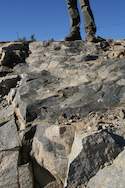An Extra-Terrestrial Impact

Apart from the Vredefort crater, the colossal impact event left behind many other traces, recorded in the rocks.
These features have been found at dozens of other impact sites across the planet, and are now considered to be the hallmarks of an extra-terrestrial impact event.
First, there is a thick layer of ejected material that fell in a heavy rain across a radius of several hundred kilometers.
This jumbled layer of boulders and shrapnel is thickest in the middle of the dome region, thinning out as you move away from the centre.
The next clear indication of the vast forces at work is changes to the rocks themselves. When a bolide hits, it can generate temperatures over 10 000 degrees centigrade and exerts hundreds of gigapascals of pressure.
This enormous amount of energy and heat causes the surrounding rocks to change into new forms.
This process is known as ‘shock metamorphics’. One of the more obvious of these metamorphic features is ‘shattercones’.
A Shattercone
A shattercone is not what you get when you drop your ice-cream. Instead, it is a specific fracture pattern that spreads over the rocks as the shock wave passes through. The result is a repetitive triangular formation, emanating from a common point.
These shattercones are exposed at a number of sites throughout the Vredefort Dome, and it is said that if you line up all the shattercones correctly, you can work out the bolide’s line of descent.
Unfortunately, modern visitors are starting to break off shattercones as souvenirs. This is a deplorable habit that must be stopped and protection of the shattercones will be one of the responsibilities of the new Dome Management Authority.
Metamorphosis of the Rocks
Another prominent characteristic of the Vredefort rocks is the veins of dark material that streak through the lighter granite. These seams vary in length and thickness, but some are quite substantial. This type of glassy, dark rock is called ‘pseudotachylite’ and it is formed when extremely high temperatures cause rock to melt and change its chemical composition.
Similar tachylite rocks are found around volcanoes and along fault lines (where friction between the tectonic plates causes heat to be released). The term ‘pseudo’ is added when there is no evidence of volcanic activity. The incredible temperature and pressure released by the impact also created another large-scale metamorphosis of the rocks, called ‘granophyre’.
This is a dark matrix of fine rock particles that have collected in fractures and formed into large, narrow dykes of melt-rock, extending over several kilometers. Radiometric dating of zircon particles in these impact-deformed rocks helped geologists give the Vredefort event a specific date of 2.023 billion years.
Shock-Deformation Features
Among the other important shock-deformation features common to many impact sites are coesite and stishovite. These are the formidable names given to two ultra-dense forms of quartz (a common mineral in rocks). They are created when quartz is compressed and heated to such a degree that it changes its crystal lattice structure.
Traces of both minerals are regularly found in impact craters, and around nuclear bomb testing sites. The generic term for this kind of deformation is ‘shocked quartz’. The final evidence of shock metamorphism cannot be seen with the naked eye.
Careful investigations, in which rocks are delicately sliced and then examined under an electron microscope, have shown micro-deformations at an atomic level. These manifest as planar disturbances in the quartz crystals and, when present, are a strong indication of an impact event.
Impact Diamonds
One interesting shock deformation not found at Vredefort is ‘impact diamonds’. These tiny spherical gems, measuring a fraction of a millimetre across, are formed when a meteorite hits into carbon-rich rock. The heat from the impact reacts with the carbon to form millions of miniscule diamonds.
The Popigai crater in Siberia reputedly contains millions of tons of impact diamonds, but no-one has worked out a use for them. A combination of shattercones, pseudotachylite, shocked quartz and all the other shock metamorphics have been found at Vredefort and many other impact craters. Together, they are taken as the signature of an impact event and have been used to identify dozens of previously unknown impact sites around the planet.
By David Fleminger